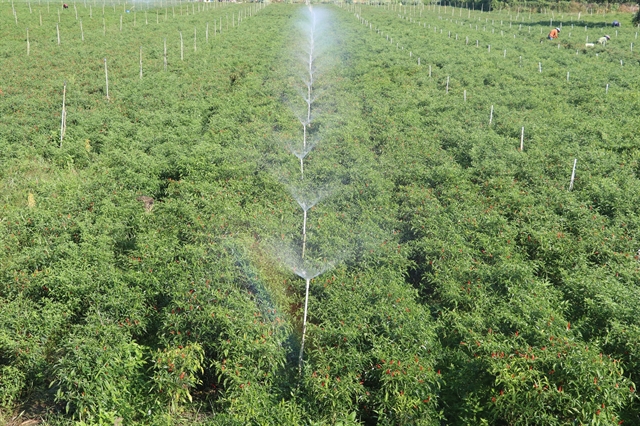 Society
Society

The Đồng Tháp Province People’s Committee has decided to switch to other crops on 9,386ha of rice fields this year.

|
| An efficient irrigation system in a red chilli field in Đồng Tháp Province’s Cao Lãnh District. – VNA/VNS Photo Nguyễn Văn Trí |
ĐỒNG THÁP — The Đồng Tháp Province People’s Committee has decided to switch to other crops on 9,386ha of rice fields this year.
A part of the area will see corn, watermelon, red chilli, lotus, and other high-value crops and aquatic species rotated with rice, while rice will no longer be grown in the remaining area.
The conversion is aimed at increasing the value of crops and improving the efficiency of land use, thus increasing farmers’ incomes.
Huỳnh Tấn Đạt, deputy director of the province Department of Agriculture and Rural Development, said the conversion is in line with the province’s land zoning, market demand, water resources, and weather conditions.
It will also establish concentrated farming areas for various crops under value chains, he said.
The People’s Committee has ordered localities to zone concentrated farming areas for vegetables and fruits, invest in infrastructure for cropping and processing.
Localities should instruct farmers to link up with companies that buy produce, it said.
Farmers are also encouraged to switch to short-term crops in summer – autumn on unproductive rice fields to cope with the shortage of water in the dry season.
In areas protected by flood prevention embankments, farmers can switch to two rice crops and one vegetable crop a year, one rice crop and two vegetable crops, or one rice crop and one vegetable crop.
The switch will offer farmers higher profits than growing three rice crops a year, according to the department.
Đạt said farmers could earn two to three times the income they get from rice by switching to other crops, with perennial trees yielding two to eight times.
Mango, jackfruit, longan, and lime, for instance, fetch VNĐ50 - 200 million (US$2,100 – 8,500) per hectare per year, he said.
Mai Thị Thoa in Hồng Ngự City’s Tân Hội Ward has turned her one hectare of unproductive rice field into a lotus pond and offers tourism services.
Her income has increased by two or three times to VNĐ60 million ($2,600) a year as a result, she said.
The province encourages farmers to mechanise agriculture to increase efficiency, and 70 per cent of areas growing industrial and short-term crops are equipped with automatic, semi-automatic or drip irrigation, according to the department.
The use of efficient irrigation has increased yields by 25 per cent and reduced labour costs by 30 per cent and water use by 30 – 40 per cent.
Linkages
Đồng Tháp has taken measures to develop more linkages between farmers and agricultural companies in recent years to ensure steady demand and prices for the former and supply of large quantities of agricultural produce of consistent and high quality for the latter.
In the winter – spring and summer – autumn rice crops this year, companies and traders had contracts with farmers to grow rice on 60,000ha, and it helped the latter increase their income by VNĐ3 - 8 million ($130 - 340) per hectare per crop, according to the department.
The province has 195,383ha under rice, 48,229ha of fruits and 11,587ha of vegetables, and issued production codes for 52,777ha of the grain and 5,714ha of mango, longan, seedless lime, and dragon fruit this year.
To get the codes, a fruit farmer should have at least 10ha and apply Vietnamese good agricultural practices (VietGAP) or other equivalent quality standards.
The province wants to have 190,169ha of rice, 40,810ha of fruits and 10,549ha of vegetables with production codes by 2025. — VNS




